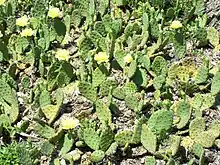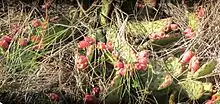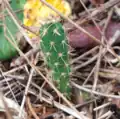Opuntia humifusa
Opuntia humifusa, commonly known as the devil's-tongue,[2] eastern prickly pear or Indian fig, is a cactus of the genus Opuntia present in parts of the eastern United States, Mississippi and northeastern Mexico.[3]
| Eastern prickly pear | |
|---|---|
 | |
| Scientific classification | |
| Kingdom: | Plantae |
| Clade: | Tracheophytes |
| Clade: | Angiosperms |
| Clade: | Eudicots |
| Order: | Caryophyllales |
| Family: | Cactaceae |
| Genus: | Opuntia |
| Species: | O. humifusa |
| Binomial name | |
| Opuntia humifusa (Raf.) Raf. | |

Description
As is the case in other Opuntia species, the green stems of this low-growing perennial cactus are flattened, and are formed of segments. Barbed bristles are found around the surfaces of the segments, and longer spines are sometimes present.[4] The flowers are yellow to gold in color, and are found along the margins of mature segments. The flowers are waxy and sometimes have red centers. They measure 4–6 cm (1+5⁄8–2+3⁄8 in) across. This cactus blooms in the late spring.
The juicy red or purple fruits measure from 3–5 cm (1+1⁄8–2 in). As the fruit matures, it changes color from green to red, and often remains on the cactus until the following spring. There are 6 to 33 small, flat, light-colored seeds in each fruit.
Taxonomy
Some botanists treat this cactus as a variety of O. compressa: hence O. c. var. humifusa, or a synonym of O. compressa. Those recognizing this species treat O. rafinesquii as a junior synonym.
Distribution
This species naturally occurs along the East Coast of the United States, including on barrier islands from the Florida Keys to coastal Massachusetts.[5] Eastern prickly pear is found in scattered locations from New Mexico and Montana eastward,[6] and is one of two cactus species native to the eastern United States, along with the related O. cespitosa.[7] Since eastern prickly pear grows in hot, sunny locations with thin soil that does not hold water, it is found in shale barrens, which are accumulations of thin, flat, eroded sedimentary rock on steep slopes with southern exposures - essentially a desert microclimate - in the Appalachian Mountains.[8][9]
Habitat
This plant is very intolerant of shade and instead thrives in sunny, hot and dry environments with well-draining, sandy soil.[10] O. humifusa will grow in open areas in sandy, rocky and coastal scrub habits. It is capable of surviving cool winters unlike many cacti, although harsh winter storms are known to cause habitat loss.[10]
Uses
The fruits are edible,[11] but have small spiny bristles. The pulp can be scooped and the seeds strained out to make syrup or jelly. The seeds can be briefly roasted and ground into meal.[12] Young cactus segments can be roasted to remove spines, then peeled and sliced to be eaten like string beans; alternatively, they can be deep fried. The leafy segments can be peeled and chewed for emergency hydration.[12]
Gallery
 Fruit in South Carolina
Fruit in South Carolina Growing wild in coastal habitat, Milford Connecticut
Growing wild in coastal habitat, Milford Connecticut Growing wild in northern Illinois (partial shade)
Growing wild in northern Illinois (partial shade) Close-up of yellow barbed bristles and longer spines
Close-up of yellow barbed bristles and longer spines Seedling; notice the larger spines
Seedling; notice the larger spines Flowers
Flowers
References
- Majure, L. 2017. Opuntia humifusa (amended version of 2013 assessment). The IUCN Red List of Threatened Species 2017: e.T152374A121591012. https://dx.doi.org/10.2305/IUCN.UK.2017-3.RLTS.T152374A121591012.en. Downloaded on 19 June 2021.
- USDA, NRCS (n.d.). "'Opuntia humifusa'". The PLANTS Database (plants.usda.gov). Greensboro, North Carolina: National Plant Data Team. Retrieved 23 July 2015.
- "Opuntia humifusa (Raf.) Raf." Plants of the World Online. Royal Botanic Gardens, Kew. Retrieved 2023-01-26.
- "4. Opuntia humifusa", Flora of North America
- Eastern Prickly Pear Opuntia humifusa (PDF) (Report). Natural Heritage & Endangered Species Program, Massachusetts Division of Fisheries & Wildlife. Archived from the original (PDF) on September 21, 2018.
- "Opuntia humifusa (Eastern Prickly Pear Cactus) | North Carolina Extension Gardener Plant Toolbox". Plants.ces.ncsu.edu. Retrieved 24 June 2022.
- "Lady Bird Johnson Wildflower Center - The University of Texas at Austin". Wildflower.org. Retrieved 24 June 2022.
- "Cactuses, and the Spine of Appalachia". Carnegie Museum of Natural History. 17 July 2018. Retrieved 24 June 2022.
- "Appalachian Shale Barrens" (PDF). Conservationgateway.org. Retrieved 24 June 2022.
- "Species Profile (Eastern Prickly Pear Cactus) - Species at Risk Public Registry". Wildlife-species.canada.ca. Retrieved 2020-04-15.
- Niering, William A.; Olmstead, Nancy C. (1985) [1979]. The Audubon Society Field Guide to North American Wildflowers, Eastern Region. Knopf. p. 436. ISBN 0-394-50432-1.
- Elias, Thomas S.; Dykeman, Peter A. (2009) [1982]. Edible Wild Plants: A North American Field Guide to Over 200 Natural Foods. New York: Sterling. p. 139. ISBN 978-1-4027-6715-9. OCLC 244766414.
External links
 Media related to Opuntia humifusa at Wikimedia Commons
Media related to Opuntia humifusa at Wikimedia Commons- Flowering Opuntia humifusa
- Canadian government recovery strategy for Eastern Prickly Pear
- University of Florida - Gardening Solutions - Prickly pear
- Opuntia humifusa images at bioimages.vanderbilt.edu
- Opuntia humifusa photo gallery at Opuntia Web
